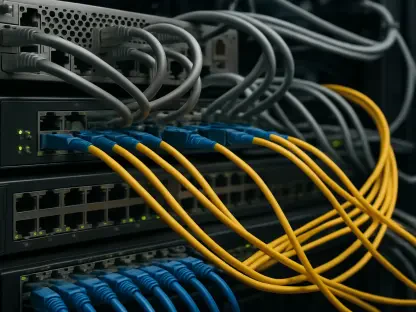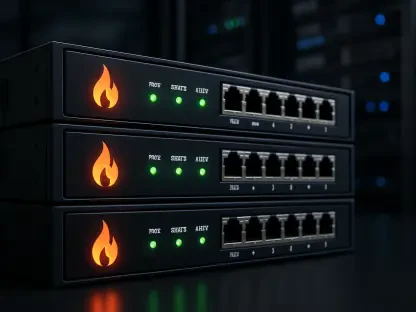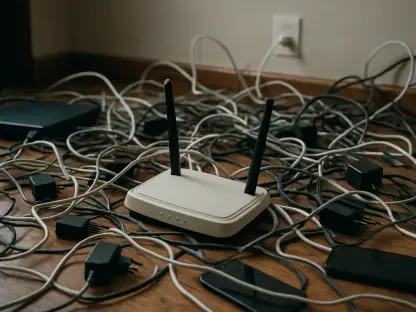In an era where seamless connectivity is no longer a luxury but a necessity, Semtech Corporation (SMTC) has emerged as a quiet yet formidable contender in the semiconductor and Internet of Things (IoT) arenas, with its latest Q2 earnings report hinting at a pivotal moment. As industries from healthcare to industrial automation increasingly rely on advanced 5G and IoT solutions, Semtech’s strategic focus on innovative technologies positions it to potentially redefine how the world connects. This isn’t just about keeping up with trends; it’s about addressing real, pressing needs in a digital-first landscape. But with economic uncertainties and a cautious investor outlook, the question remains whether Semtech can translate its technical prowess into market dominance. Diving into the company’s financials, innovations, and challenges offers a clearer picture of its trajectory in these high-stakes sectors.
Financial Performance and Outlook
Earnings Snapshot for Q2
Semtech’s financial results for the second quarter reveal a deliberate emphasis on profitability over aggressive revenue expansion, a prudent choice amid today’s high-interest-rate climate. The company reported a 4% sequential revenue increase to $215.4 million, alongside a non-GAAP gross margin of 50.4%, which reflects a 60-basis-point improvement from the prior quarter. Additionally, the adjusted EBITDA margin climbed to 18.8%, up by 270 basis points, showcasing a commitment to operational efficiency. While these numbers indicate a steady hand at the helm, they also highlight a tempered growth pace that might not immediately ignite investor enthusiasm. This balance between fiscal discipline and modest top-line gains paints Semtech as a company playing the long game, focusing on sustainable margins over short-term spikes.
The significance of these figures lies in what they suggest about Semtech’s market strategy. Unlike some competitors chasing rapid expansion at the cost of profitability, Semtech appears to prioritize a stable foundation, particularly in an environment where economic pressures can swiftly erode gains. This approach could serve as a buffer against volatility, but it also raises concerns about whether the company is moving fast enough to capture emerging opportunities in 5G and IoT. Investors are likely watching to see if this cautious stance will pay off as new product cycles mature and market conditions evolve. For now, the financials reflect a measured optimism, with room for growth if execution aligns with ambition.
Projections for the Near Term
Looking ahead to the third quarter, Semtech anticipates revenue of approximately $233 million, with a non-GAAP gross margin of around 52.0%, signaling continued improvement in profitability metrics. These projections, while not explosive, suggest a trajectory of steady enhancement in operational performance, which could build confidence over time. However, the absence of significant revenue growth in the guidance points to potential delays in market adoption of newer offerings. Meeting full-year consensus estimates for revenue and earnings per share is expected, yet there’s little in the forecast to suggest an immediate breakout moment for the stock. This outlook underscores a narrative of stability rather than dynamism at this stage.
Beyond the numbers, the guidance also reflects broader industry dynamics where semiconductor firms must navigate uneven demand cycles. Semtech’s conservative projections may be a response to external uncertainties like supply chain constraints or softening industrial demand, which could impact short-term results. For stakeholders, this raises the question of whether the company’s focus on margin improvement will be enough to offset slower top-line growth. While the near-term outlook doesn’t dazzle, it sets a baseline from which Semtech could build if strategic initiatives gain traction. The coming quarters will be critical in determining whether this cautious optimism translates into tangible market share gains.
Strategic Innovations Driving Growth
Advancements in 5G RedCap and LoRa Technology
Semtech’s innovation pipeline is a key pillar of its growth strategy, particularly with its development of 5G Reduced Capability (RedCap) modules such as the HL7900 and EM8695, which are designed for low-power, wide-area connectivity. These solutions are finding relevance in high-demand sectors like industrial automation and healthcare, where cost-effective and reliable communication is paramount. Complementing this, the LoRa ecosystem, with over 178 million connected devices, continues to expand access to IoT for small and medium-sized businesses as well as smart home applications. The blend of 5G’s global scalability with LoRa’s long-range, low-power strengths creates a versatile framework that addresses diverse connectivity needs across fragmented markets.
This dual approach is more than just a technical achievement; it positions Semtech as a bridge between niche and mainstream connectivity demands. The certifications of modules like the EM8695 by the FCC and PTCRB enhance their readiness for adoption by global telecom carriers, potentially accelerating deployment. Meanwhile, innovations like the one-channel LoRaWAN hub reference design target accessibility, lowering entry barriers for smaller players. If Semtech can sustain this momentum, it could carve out a leadership role in unifying disparate IoT ecosystems. However, the speed of market acceptance remains a variable that could shape the impact of these technologies in the near future.
Expansion into Data Center Connectivity
Semtech is also making strategic inroads into the data center market, a critical area as the industry shifts toward 224G/lane infrastructure to support escalating data demands. Products like the CopperEdge linear redrivers, tailored for 200 Gbps applications, are currently under evaluation by over 20 customers, including major hyperscalers, highlighting their relevance to power efficiency and thermal management challenges. Additionally, the Tri-Edge transimpedance amplifiers strengthen Semtech’s presence in high-speed optical markets, with design wins anticipated before fiscal 2026. These developments align with the sector’s need for faster, more efficient solutions, positioning Semtech as a contender in this high-growth space.
The potential of these data center solutions extends beyond immediate revenue to long-term relevance in an industry increasingly driven by cloud and AI workloads. Semtech’s ability to address specific pain points like energy consumption and speed could differentiate it from broader semiconductor players. While the evaluation phase with hyperscalers is promising, securing these partnerships into firm contracts will be crucial for validating this pivot. Should Semtech achieve significant design wins, this segment could become a substantial growth driver, complementing its IoT focus. The coming months will test whether this strategic expansion can deliver on its early promise amidst fierce competition.
Market Challenges and Resilience
Navigating Economic Headwinds
Semtech operates in a landscape fraught with macroeconomic challenges that could temper its growth ambitions in the short term. Inflationary pressures, geopolitical tensions, and a noticeable slowdown in the industrial sector pose risks to demand for semiconductor and IoT solutions. These external factors create a layer of uncertainty, potentially delaying investments in connectivity infrastructure by key industries. While Semtech has shown operational discipline, the broader economic environment could still impact customer budgets and project timelines, testing the company’s ability to maintain its growth trajectory under pressure.
These challenges are not unique to Semtech but reflect a wider industry struggle to balance innovation with economic realities. The risk of reduced capital expenditure in sectors like manufacturing could slow the adoption of advanced 5G and IoT technologies, even if the long-term outlook remains positive. For Semtech, navigating this volatility will require agility in adjusting to shifting demand patterns while continuing to invest in strategic areas. The extent to which these headwinds persist could shape the pace at which the company realizes its potential, making adaptability a critical factor in the near term.
Building Strategic Defenses
Despite the looming economic uncertainties, Semtech has positioned itself with buffers that could mitigate some of these risks. A focus on less cyclical markets such as infrastructure and high-end consumer applications provides a degree of stability, as these sectors often maintain demand even during downturns. Furthermore, the acquisition of Sierra Wireless has enhanced Semtech’s cellular IoT portfolio, enabling end-to-end solutions that set it apart from competitors. This strategic move not only broadens its market reach but also strengthens its resilience against sector-specific softness.
This emphasis on diversified, stable markets and comprehensive offerings reflects a calculated approach to weathering external storms. By aligning with areas of persistent need, Semtech reduces its exposure to the volatility affecting more discretionary segments of the tech industry. The integration of Sierra Wireless’s capabilities also offers a competitive edge, allowing for more tailored solutions that could drive customer loyalty. While these strategies don’t eliminate macro risks, they provide a foundation from which Semtech can push forward. Sustaining this resilience will depend on how effectively these buffers translate into consistent performance over time.
Investment Perspective
Gauging Market Sentiment
From an investment angle, Semtech presents a complex picture characterized by caution rather than exuberance. With a Zacks Rank of #3 (Hold) and a forward P/E ratio of approximately 14x, the company trades at a discount compared to peers, which might attract value-focused investors. However, this valuation also signals market skepticism about Semtech’s ability to deliver consistent growth in the near term. The absence of earnings surprise potential further contributes to a wait-and-see attitude among analysts and shareholders, reflecting broader uncertainties in the semiconductor space.
This muted sentiment isn’t solely about Semtech’s performance but mirrors wider concerns about macroeconomic conditions and industry headwinds. The discounted valuation could be seen as an opportunity for those willing to take a contrarian stance, yet it also underscores the lack of immediate catalysts to drive stock momentum. For now, the market appears to be withholding judgment, awaiting clearer evidence of Semtech’s ability to convert its strategic initiatives into tangible financial gains. This cautious outlook suggests that short-term upside may remain limited until more definitive progress emerges.
Eyeing Future Opportunities
For investors with a longer-term horizon, Semtech holds intriguing potential tied to specific growth catalysts that could reshape its trajectory. The rollout of 5G RedCap modules and potential design wins in the data center segment stand out as pivotal developments that might drive both revenue and margin expansion. These initiatives, if successful, could position Semtech as a leader in connectivity solutions, tapping into the escalating demand for IoT and high-speed infrastructure. However, realizing this potential will require patience, as macro challenges and the pace of market adoption remain variables.
These future opportunities highlight the importance of strategic execution in unlocking value. The successful deployment of 5G solutions across industries and securing key partnerships in data centers could serve as turning points, elevating Semtech’s profile among investors. While the near-term outlook suggests caution, monitoring these catalysts over the coming quarters will be essential for assessing the company’s ability to capitalize on broader industry trends. A measured approach, balancing risk with the promise of innovation, will likely define the investment case for Semtech as it navigates this critical phase.
Reflecting on Semtech’s Path Forward
Looking back, Semtech’s journey through its recent earnings cycle revealed a company that adeptly balanced operational discipline with ambitious innovation in high-growth areas like 5G, IoT, and data center connectivity. The measured financial improvements and strategic advancements underscored a deliberate effort to build a sustainable foundation amidst a challenging landscape. For those tracking the company’s progress, the focus now shifts to actionable next steps. Keeping a close eye on the adoption rates of 5G RedCap modules and the outcomes of data center evaluations will be crucial in gauging near-term success. Additionally, exploring how Semtech further integrates its expanded capabilities to address evolving industry needs could offer deeper insights into its competitive edge. As the connectivity landscape continues to transform, staying informed about Semtech’s ability to adapt and seize emerging opportunities will be key for stakeholders aiming to understand its long-term impact.









